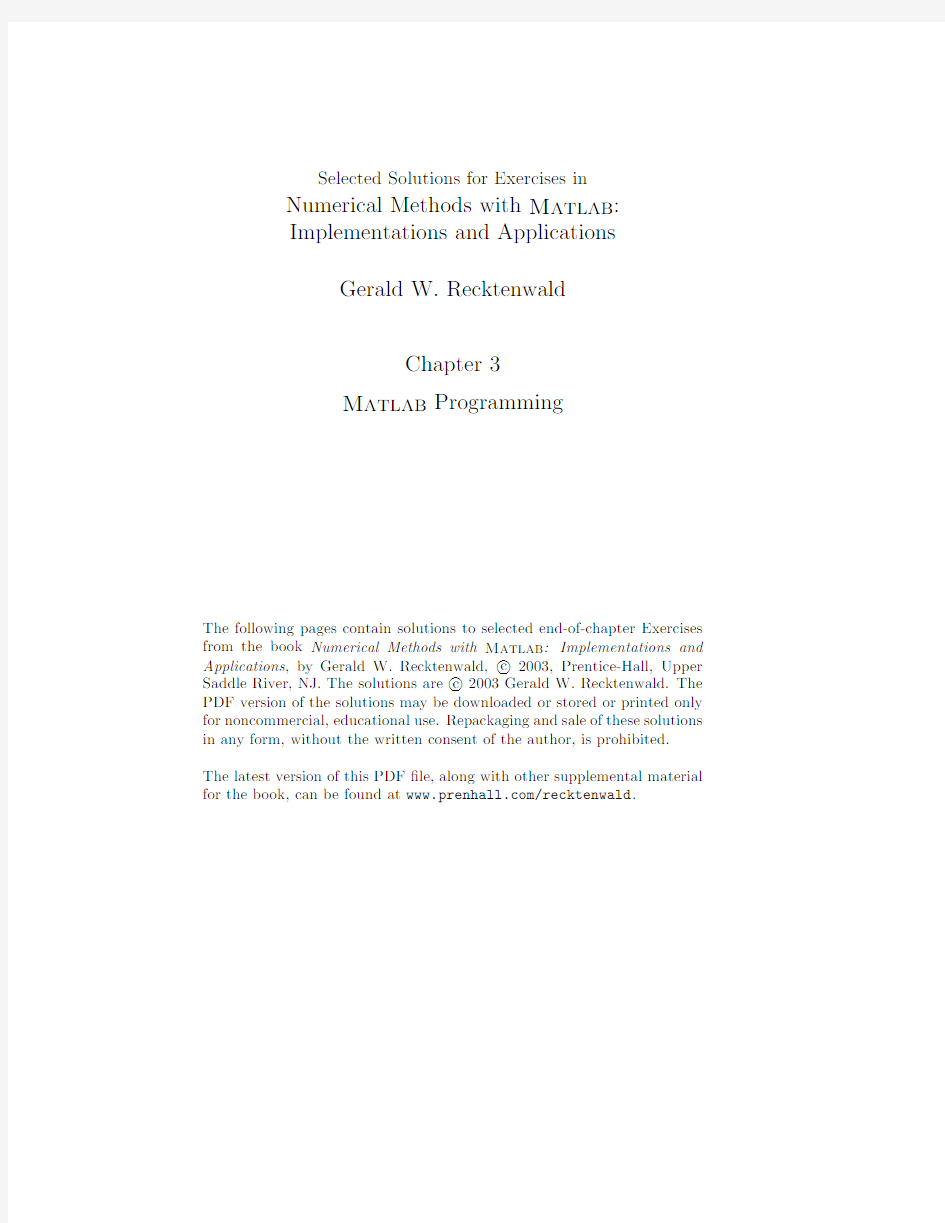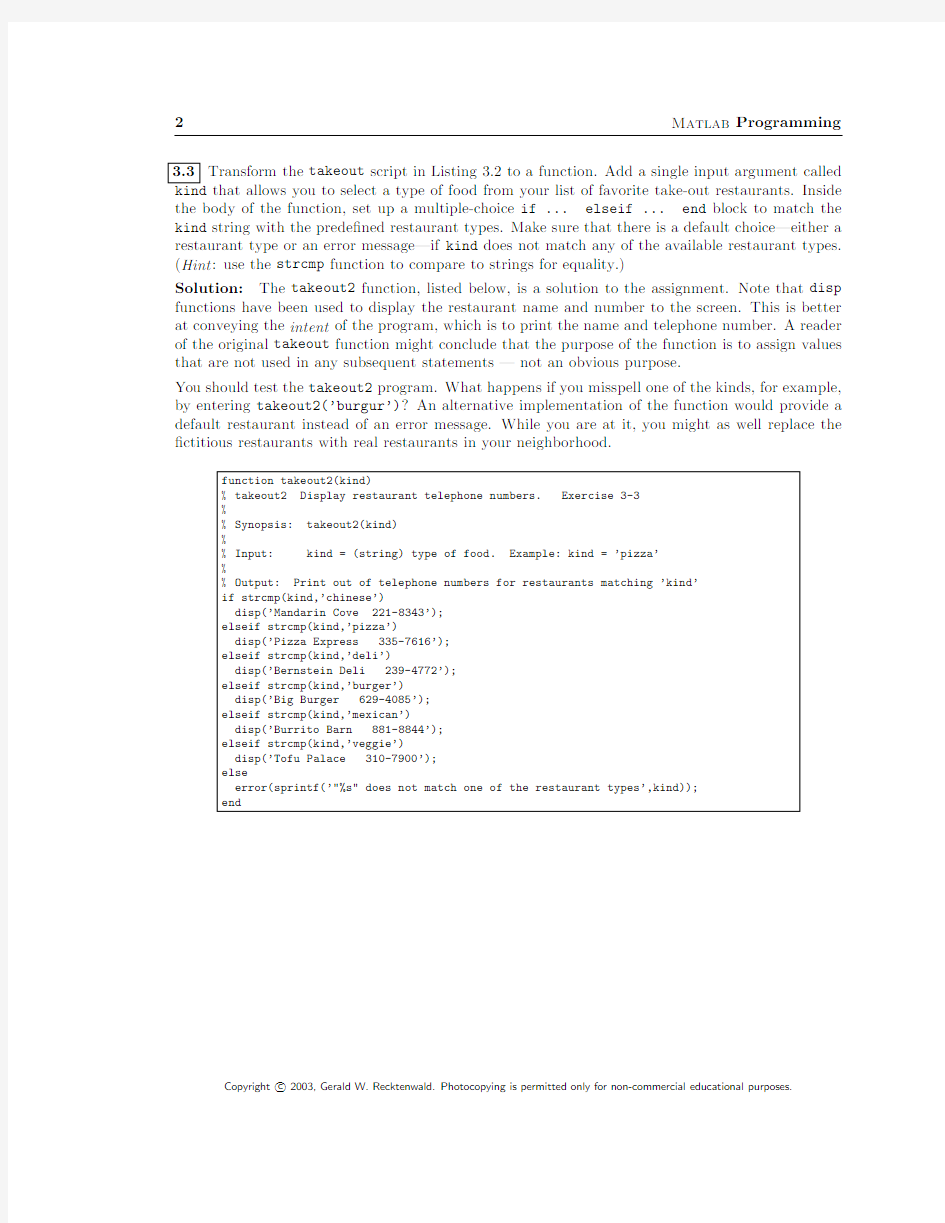ch03partSolution


Selected Solutions for Exercises in
Numerical Methods with Matlab:
Implementations and Applications
Gerald W.Recktenwald
Chapter3
Matlab Programming
The following pages contain solutions to selected end-of-chapter Exercises
from the book Numerical Methods with Matlab:Implementations and
Applications,by Gerald W.Recktenwald,c 2003,Prentice-Hall,Upper Saddle River,NJ.The solutions are c 2003Gerald W.Recktenwald.The
PDF version of the solutions may be downloaded or stored or printed only
for noncommercial,educational use.Repackaging and sale of these solutions
in any form,without the written consent of the author,is prohibited.
The latest version of this PDF?le,along with other supplemental material for the book,can be found at https://www.360docs.net/doc/fc17875321.html,/recktenwald.
2Matlab Programming 3.3Transform the takeout script in Listing3.2to a function.Add a single input argument called kind that allows you to select a type of food from your list of favorite take-out restaurants.Inside the body of the function,set up a multiple-choice if...elseif...end block to match the kind string with the prede?ned restaurant types.Make sure that there is a default choice—either a restaurant type or an error message—if kind does not match any of the available restaurant types. (Hint:use the strcmp function to compare to strings for equality.)
Solution:The takeout2function,listed below,is a solution to the assignment.Note that disp functions have been used to display the restaurant name and number to the screen.This is better at conveying the intent of the program,which is to print the name and telephone number.A reader of the original takeout function might conclude that the purpose of the function is to assign values that are not used in any subsequent statements—not an obvious purpose.
You should test the takeout2program.What happens if you misspell one of the kinds,for example, by entering takeout2(’burgur’)?An alternative implementation of the function would provide a default restaurant instead of an error message.While you are at it,you might as well replace the ?ctitious restaurants with real restaurants in your neighborhood.
function takeout2(kind)
%takeout2Display restaurant telephone numbers.Exercise3-3
%
%Synopsis:takeout2(kind)
%
%Input:kind=(string)type of food.Example:kind=’pizza’
%
%Output:Print out of telephone numbers for restaurants matching’kind’
if strcmp(kind,’chinese’)
disp(’Mandarin Cove221-8343’);
elseif strcmp(kind,’pizza’)
disp(’Pizza Express335-7616’);
elseif strcmp(kind,’deli’)
disp(’Bernstein Deli239-4772’);
elseif strcmp(kind,’burger’)
disp(’Big Burger629-4085’);
elseif strcmp(kind,’mexican’)
disp(’Burrito Barn881-8844’);
elseif strcmp(kind,’veggie’)
disp(’Tofu Palace310-7900’);
else
error(sprintf(’"%s"does not match one of the restaurant types’,kind));
end
Copyright c 2003,Gerald W.Recktenwald.Photocopying is permitted only for non-commercial educational purposes.
Chapter3:Matlab Programming3 3.5Write a newtsqrt function to compute the square root of a number,using Newton’s algorithm.
Your function should encapsulate the code on page115.
Solution:A version of newtsqrt is listed below.Does it work?What are the results of newtsqrt(4), newtsqrt(400),newtsqrt(4e-16)?
function r=newtsqrt(x,delta,maxit)
%newtsqrt Newton’s method for computing the square root of a number
%Exercise3-5
%
%Synopsis:r=newtsqrt(x)
%r=newtsqrt(x,delta)
%r=newtsqrt(x,delta,maxit)
%
%Input:x=number for which the square root is desired
%delta=(optional)convergence tolerance.Default:delta=5e-6
%maxit=(optional)maximum number of iterations.Default:maxit=25
%
%Output:r=square root of x to within relative tolerance of delta
%The kth iterate for the square root of x is
%
%r(k)=0.5*(r(k-1)+x/r(k-1))
%
%Iterations are terminated after maxit iterations or
%when abs(r(k-1)-r(k))/r(k-1) if x<0,error(’Negative input to newtsqrt not allowed’);end if nargin<2,delta=5.0e-6;end%Defaults for optional input arguments if nargin<3,maxit=25;end r=x;%Initialize rold=2*r;%Make sure convergence test fails on first try it=0; while abs(rold-r)/rold>delta&it rold=r;%Save old value for convergence test r=0.5*(rold+x/rold);%Update the guess at the root it=it+1;%Increment the iteration counter end Copyright c 2003,Gerald W.Recktenwald.Photocopying is permitted only for non-commercial educational purposes. 4Matlab Programming 3.7Elvis Presley was born January8,1935,and died on August16,1977.Write an elvisAge function that returns Elvis’s age in years,assuming that he were alive today.(The fragment of code on page103may be of some help.) Solution:The elvisAge1function is listed on the following page.Does it work? function y=elvisAge1 %elvisAge Compute age of Elvis Presley(assuming he’s still alive) %Solutions to Exercise3-7 % %Synopsis:y=elvisAge1 % %Input:none % %Output:y=years since Elvis was born on8January1935 theDate=datevec(now);%measure age from today’s date birthdate=datevec(datenum(1935,1,8)); deltaTime=theDate-birthdate;%vector of time differences y=deltaTime(1); if(birthdate(2)>=theDate(2))&(birthdate(3)>theDate(3)) y=y-1;%birthdate hasn’t happened yet this month end Copyright c 2003,Gerald W.Recktenwald.Photocopying is permitted only for non-commercial educational purposes. Chapter3:Matlab Programming5 3.10Write a function called mydiag that mimics the behavior of the built-in diag function.At a minimum,the mydiag function should return a diagonal matrix if the input is a vector,and return the diagonal entries of the matrix if the input is a matrix.(Hint:The size function will be helpful.) Partial Solution:An incomplete version of the myDiag function is listed below.Your job is to ?nish myDiag and verify that it https://www.360docs.net/doc/fc17875321.html,e the demoMyDiag function,listed on the next page,and any other tests you wish to devise,to validate your implementation of myDiag. function D=myDiag(A) %myDiag Create a diagonal matrix,or extract the diagonal of a matrix % %Synopsis:D=myDiag(A)to extract a diagonal elements from a matrix A % %Input:A=a vector or a matrix % %Output:If A is a vector,D is a diagonal matrix with the elements %of v on the diagonal.If A is a matrix,D is a vector %containing the diagonal elements of A. [m,n]=size(A); if min(m,n)==1%input is a vector r=max(m,n);%m=1or n=1,pick largest to dimension D D=zeros(r,r); ...your code here else%input is a matrix ...your code here end function demoMyDiag %demoMyDiag Test the myDiag function.Exercise3-10 %---Test creation of diagonal matrices fprintf(’\nVerify that myDiag correctly creates diagonal matrices\n’); fprintf(’m error\n’); for m=[1471320] v=rand(m,1); D1=diag(v); D2=myDiag(v); fprintf(’%3d%12.3e\n’,m,norm(D1-D2,Inf)); end %---Test extraction of diagonal vector fprintf(’\nVerify that myDiag correctly extracts the diagonal of a matrix\n’); fprintf(’m n error\n’); for m=[1420] for n=[1517] A=rand(m,n); d1=diag(A); d2=myDiag(A); fprintf(’%3d%3d%12.3e\n’,m,n,norm(d1-d2)); end end Running demoMyDiag for a correct implementation of myDiag gives Copyright c 2003,Gerald W.Recktenwald.Photocopying is permitted only for non-commercial educational purposes. 6Matlab Programming >>demoMyDiag Verify that myDiag correctly creates diagonal matrices m error 10.000e+00 40.000e+00 70.000e+00 130.000e+00 200.000e+00 Verify that myDiag correctly extracts the diagonal of a matrix m n error 110.000e+00 15-0.000e+00 117-0.000e+00 41-0.000e+00 450.000e+00 4170.000e+00 201-0.000e+00 2050.000e+00 20170.000e+00 Copyright c 2003,Gerald W.Recktenwald.Photocopying is permitted only for non-commercial educational purposes. Chapter3:Matlab Programming7 3.16Write the Matlab statements that use a loop and the fprintf function to produce the following table(the format of the numerical values should agree exactly with those printed in the table). theta sin(theta)cos(theta) 00.0000 1.0000 600.86600.5000 1200.8660-0.5000 180-0.0000-1.0000 240-0.8660-0.5000 300-0.86600.5000 3600.0000 1.0000 Partial Solution:The body of the loop can be one line: fprintf(’%6d%9.4f%9.4f\n’,thetad(k),sin(thetar(k)),cos(thetar(k))) Many other loop blocks can be made to work. Copyright c 2003,Gerald W.Recktenwald.Photocopying is permitted only for non-commercial educational purposes. 8Matlab Programming 3.22Write a function to plot the displacement of a cantilevered beam under a uniform load.In addition to creating the plot,the function should return the maximum de?ection and angle between the horizontal and the surface of the beam at its tip.The formulas for the displacement y and tip angleθare y=?wx2 24EI 6L2?4Lx+x2 andθ= 1 6 wL3 EI , where w is the load per unit length,E is Young’s modulus for the beam,I is the moment of inertia of the beam,and L is the length of the beam.Test your function with E=30Mpsi,I=0.163in4, L=10in,w=100lb f/in. Partial Solution:The cantunif function,listed below,evaluates the formulas for the displace-ment y and tip angleθfor any set of E,I,L,and w values.The cantunif function also plots y(x). To complete the Exercise,the cantunif function is called with the appropriate inputs.What is the value of y max andθfor the given values of E,I,L,and w? function[ymax,theta]=cantunif(E,I,L,w) %cantunif Plot the deflection of a uniformly loaded cantilevered beam. %Return the maximum deflection and the slope at the tip.Exercise3-22 % %Synopsis:[ymax,theta]=cantunif(E,I,L,w) % %Input:E=Young’s modulus %I=moment of inertia of the beam %L=length of the beam %w=uniform load on the beam(weight per unit length) % %NOTE:inputs must have internally consistent units % %Output:ymax=maximum deflection at the tip %theta=angle in radians between horizontal and the %beam surface at the tip x=linspace(0,L); y=-w*x.^2.*(x.^2+6*L^2-4*L*x)/(24*E*I); ymax=max(abs(y)); if ymax~=abs(y(end))%displacement formula should gives max at x=L warning(’Max displacement not at tip?’); fprintf(’y(end)=%g,ymax=%g\n’,y(end),ymax) end theta=w*L^3/(6*E*I); plot(x,y); xlabel(’Position along the beam’); ylabel(’Displacement under uniform load’); title(sprintf(’E=%g,I=%5.3f,L=%g,w=%g’,E,I,L,w)); Copyright c 2003,Gerald W.Recktenwald.Photocopying is permitted only for non-commercial educational purposes. Chapter3:Matlab Programming9 3.28The corvRain.dat?le in the data directory of the NMM toolbox contains monthly precipi-tation data for Corvallis,Oregon,from1890to1994.The data are organized into columns,where the?rst column lists the year and the next12columns give the precipitation,in hundredths of an inch for each month.Write a Matlab function to compute and plot the yearly total precipitation in inches(not hundredths of an inch)from1890to1994.The function should also print the average, the highest,and the lowest annual precipitation for that period.The loadColData function in the utils directory of the NMM toolbox will be helpful in reading the data without having to delete the column headings.Can you compute the yearly total precipitation without using any loops? Partial Solution:The beginning of the precip function is listed below.This function takes a data?le(corvRain.dat in this case)as input,and computes the precipitation totals.Your job is to?nish the precip function. function precip(fname) %precip Plot precipitation data from OSU Weather Service. %Uses loadColData()function to import data and labels. % %Synopsis:precip(fname) % %Input:fname=name of file containing the plot data % %Output:Plot of annual https://www.360docs.net/doc/fc17875321.html,pute and print the average, %low and high values of yearly rainfall %Data file has13columns of data,1header of text,1row of column labels [year,P,labels]=loadColData(fname,13,1); %---Sum over rows of P to get annual precipitation. %sum(P)adds entries in each*column*of P.We need sum over %rows of the P matrix,so use sum(P’).After the sum is performed %convert from hundredths of an inch to inches,and transpose %again so that the yearly total is stored in a column vector. pt=(sum(P’)/100)’; ...your code goes here Running the completed precip function gives the following output.Note that the formatting of the output is not important.The numerical values will be helpful,however,as a check on your complete program. >>precip(’corvrain.dat’) Summary of precipitation data from file corvrain.dat Average annual precipitation=40.3inches Highest annual precipitation=58.7inches Lowest annual precipitation=23.0inches 3.31Write a function called maxi to return the index of the most positive element in a vector.In words imax=maxi(v)returns imax such that v(imax)≥v(i)for all i. Solution:The complete maxi function is listed below.To complete the Exercise,use the two parameter form of the max function to test maxi for a variety of vector inputs. Copyright c 2003,Gerald W.Recktenwald.Photocopying is permitted only for non-commercial educational purposes. 10Matlab Programming function imax=maxi(v) %maxi Given vector v,find imax such that v(imax)>=v(i)for all i %Use a for loop.Exercise3-31 imax=1; for i=2:length(v) if v(i)>v(imax),imax=i;end end Copyright c 2003,Gerald W.Recktenwald.Photocopying is permitted only for non-commercial educational purposes. Chapter3:Matlab Programming11 3.43Write an m-?le function to compute the heat transfer coe?cient for a cylinder in cross?ow. The heat transfer coe?cient h is de?ned in terms of the dimensionless Nusselt number Nu=hd/k, where d is the diameter of the cylinder and k is the thermal conductivity of the?uid.The Nusselt number is correlated with the Reynolds number Re and Prandtl number Pr by Nu=C Re m Pr1/3,where Re=ρV d μ and Pr= μc p k , in whichρ,μ,and c p are,respectively,the density,dynamic viscosity,and speci?c heat of the?uid and V is the velocity of the?uid approaching the cylinder.The parameters C and m depend on Re according to the following table: Re range c m 4—400.9110.385 40—40000.6830.466 4000—40,0000.1930.618 40,000—400,0000.0270.805 Use the following for the?rst line of your m-?le function h=cylhtc(d,v) where d is the cylinder diameter and v is the?uid https://www.360docs.net/doc/fc17875321.html,e the properties of air at one atmosphere and20?C. ρ=1.204kg/m3,μ=1.82×10?5N·s/m2,c p=1007J/(kg K),k=26.3×10?3W/(m?C) Typographical Error:In the?rst printing of the text,the value of k is given as26.3W/(m?C), which is o?by a factor of1000.The correct value of the thermal conductivity is k=26.3×10?3W/(m?C). Partial Solution:The values of c and m are set with an extended if...else construct.The beginning of the construct looks like. if Re<0.4 error(sprintf(’Re=%e is too low for correlation;min Re is0.4’,Re)); elseif Re<4 c=0.989;m=0.330; ... A demoCylhtc function(not listed here)was written to test cylhtc.Running demoCylhtc gives the following output. >>demoCylhtc diameter velocity Re h m m/s W/(m^2C) 0.0010.0080.5318.693 0.0100.008 5.29 4.035 0.2000.015198.460.937 0.200 1.50019846.1510.190 0.20015.000198461.5457.894 Copyright c 2003,Gerald W.Recktenwald.Photocopying is permitted only for non-commercial educational purposes.
